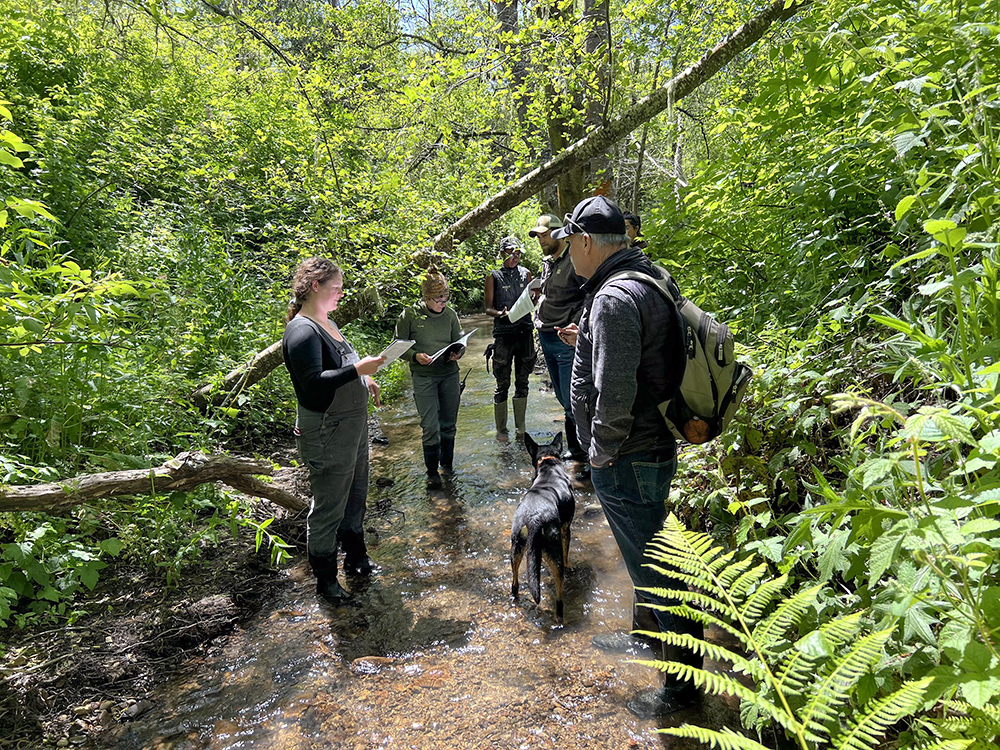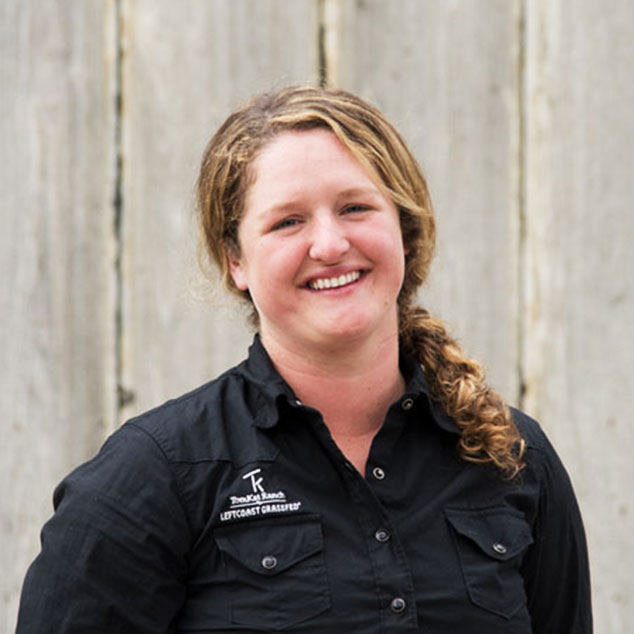There is a lot of information that goes into our adaptive grazing plan here at TomKat Ranch. We have production/grazing data which tells us historically
Out on the Ranch: Spring 2024

Wendell Gilbert, Stewardship Ecologist and Director Emeritus of the Working Lands Program at Point Blue Conservation Science, takes members of the TomKat Ranch team into Honsinger Creek to show them how to do a stream assessment.
05/23/2024
By: Hayley Strohm and many observations provided by the Land and Livestock Team
 There is a lot of information that goes into our adaptive grazing plan here at TomKat Ranch. We have production/grazing data which tells us historically how many Animal Days per Acre (ADA) we get on any given pasture at any time of year. We collect data through the Rangeland Monitoring Network and our partnership with Point Blue Conservation Science, which gives us information on birds, vegetation, soil dynamic properties, weather, and streamflow, which allows us to track our successes as well as highlight areas that may need a management change to achieve our ecological goals out on the landscapes. Currently we are partway through our third resample year as part of the Rangeland Monitoring Network which we’ve been collecting every three years since 2015! Stay tuned later this year for updates and insights into our most recent 2024 monitoring data. And while all of the information we, as a team, collect as part of our collaborative ’efforts assessment’ is essential to our long-term planning, goal setting, and monitoring, it’s the real-time observations by the livestock teams between our big sample years that are critical to our everyday adaptive management strategies.
There is a lot of information that goes into our adaptive grazing plan here at TomKat Ranch. We have production/grazing data which tells us historically how many Animal Days per Acre (ADA) we get on any given pasture at any time of year. We collect data through the Rangeland Monitoring Network and our partnership with Point Blue Conservation Science, which gives us information on birds, vegetation, soil dynamic properties, weather, and streamflow, which allows us to track our successes as well as highlight areas that may need a management change to achieve our ecological goals out on the landscapes. Currently we are partway through our third resample year as part of the Rangeland Monitoring Network which we’ve been collecting every three years since 2015! Stay tuned later this year for updates and insights into our most recent 2024 monitoring data. And while all of the information we, as a team, collect as part of our collaborative ’efforts assessment’ is essential to our long-term planning, goal setting, and monitoring, it’s the real-time observations by the livestock teams between our big sample years that are critical to our everyday adaptive management strategies.
Our field observations are the most exciting to me because they give the landscape its “feel” and they also provide the most potent information which guides day-to-day decision making. We’re paying attention to soil moisture, temperatures, rainfall, animal performance, species composition, and grass growth to make decisions about where to put the livestock and how long to leave them there. During the dry/dormant season, we have a standing feed inventory so that we know how much feed we have, allowing us to more precisely estimate the amount of feed that we will get out of a pasture and, ultimately anticipate how we will be leaving that pasture in preparation for the rains. Springtime, however, is especially dynamic! Grass growth, plant phenology, nutrition, and water content can change dramatically from week to week depending on soil moisture, temperatures, rainfall, and more, so it’s a little more complicated than working with the stockpiled feed that we have in the fall.
So, what are we seeing out there this spring? And how is that impacting our decision making?
The ground is wet! With above average rainfall for the last two years, many of our low-lying pastures are holding a lot of moisture. This is great for a lengthened growing season, which is excellent news for photosynthesis, livestock, and microbe performance. It also means that we are blocking off more pastures (mostly low-lying, and riparian adjacent) from our livestock, to avoid the added risk of pugging or compaction that would negatively affect future plant growth and soil health. Luckily the good growing conditions have caused beautiful thick swards of grass this time of year, so we are getting more out of the upland pastures that we are able to graze!
Additional spring field updates have revealed that our grazing preference for coyote brush and blackberry is higher when the soil moisture content is higher. So, this wet winter was also ideal for keeping the livestock, especially goats interested in grazing scrub longer! This preference allows the goat team to have more grazing impact on the scrub, and they are utilizing tools such as night penning in dense sections to encourage consumption, digestion, fertilizer, and trampling.
After using the goat herds to focus on shrub encroachment throughout the winter, we opened up a lot of pasture that the coyote brush and blackberry was shading out. This exposed many native perennial bunch grasses such as purple-needle grass, and California oat grass. After uncovering many of these younger bunch grasses, we are holding off on grazing these pastures to allow for longer rest for these perennial grasses to set seed, hopefully strengthening and expanding these communities’ native bunch grasses. When we do put livestock back into these fields, we will be focusing on intentionally setting back brush and less desirable plants such as thistles and early successional annual grasses.
Between the consecutive good rain years, and the added disturbance of our goat herd and prescribed fires, we are seeing some exciting results out on the land. We’ve also seen expanding communities of perennial grasses, as well as a great diversity of wildflowers, from the typical blue-eyed grass, poppies, and suncups, to red-maids and even a native tomcat clover here and there. All this diversity is telling us that we are moving in the right direction by using disturbance, rest, and recovery, along with a variety of other tools. We’re excited to continue with our grazing and land trials and observing what else spring will bring to us this year!